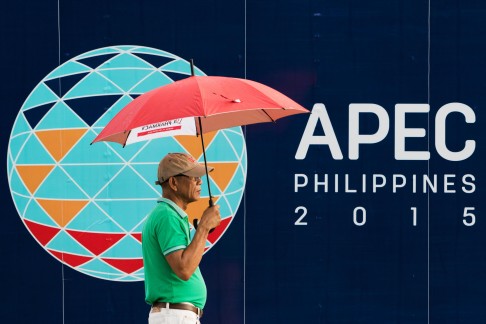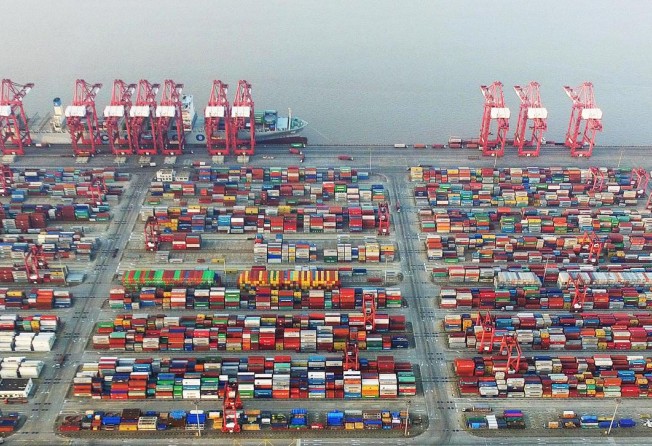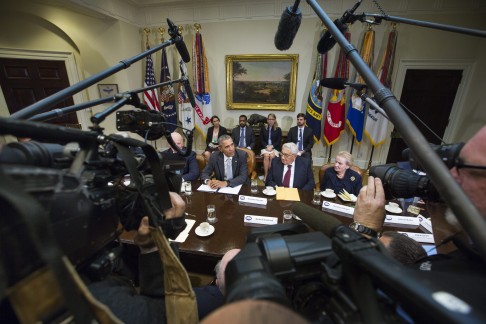
Game on: How the US and China are vying for dominance in the battle of the Asia-Pacific trade pacts
The United States and China have competing proposals to write the rules of regional commerce

In the 19th century, Britain and Russia vied for dominance in the strategically important Central Asia region in what was called the Great Game.
Two centuries later, the modern day version of strategic rivalry is being played out in the Asia-Pacific, with the United States and China competing for supremacy.
Military activity in the South China Sea has made the disputed area a hot spot for potential conflict as the two countries jostle to control sea lanes through which 40 per cent of world trade passes.
But that is not the only front - the world's biggest and second-largest economies are battling to set global trade rules. The latest round of that contest will be played out this week at the annual Asia-Pacific Economic Cooperation summit, where US President Barack Obama and his Chinese counterpart Xi Jinping will join the leaders of 21 Pacific Rim nations from today in Manila, the Philippines.
Apec was created to forge unity on free trade within the region but Xi and Obama will use the gathering to lobby other member nations to join their own-initiated trade blocs, which exclude each other.
Xi will push the China-led Apec-based Free Trade Area of the Asia-Pacific (FTAAP), while Obama will try to enlist economies, such South Korea, Indonesia and Thailand, to the US-led Trans-Pacific Partnership (TPP) cause.
It comes amid growing unease in Beijing with Washington's dominance in setting new global investment rules and free-trade agreements. Apart from the TPP, the US has been promoting the Transatlantic Trade and Investment Partnership agreement, a proposal that would cover the US and Europe to create the world's biggest free-trade zone.
Beijing sees these efforts as an attempt by Washington to check China's economic rise and has responded with a range of initiatives, including free-trade agreements.
China is a latecomer in reaching FTAs with other economies but it is making up for lost time.
But besides FTAAP initiative, Beijing is promoting talks on the Regional Comprehensive Economic Partnership (RCEP), which involves the Association for Southeast Asian Nations plus China, Japan, Korea, New Zealand, Australia, and India, but not the US.
China has also signed FTAs with 20 or so countries, from Switzerland to Chile.
In addition, it's negotiating free-trade deals with Norway, Sri Lanka and Saudi Arabia, among others.
Clearly it is not just about economics - the FTAAP and RCEP are Chinese responses to the US-led TPP, the centrepiece of Obama's "pivot to Asia" diplomacy, analysts say.
"Regrettably, geopolitics is one of the core motivations for trade-pact diplomacy in Beijing and Washington," said Benjamin Herscovitch, research manager at China Policy, a Beijing-based research and advisory company.
The FTAAP, RCEP and TPP cover a large swathe of the Asia-Pacific, an area that has become and is expected to remain an engine for world economic growth.
Louis Kuijs, head of Asia economics at Oxford Economics in Hong Kong, said the three regional arrangements differed in key ways but the FTAAP, rooted in Apec, was the most comprehensive in terms of expected signatories.
But the FTAAP has not advanced far. It is still in the embryonic stage, largely due to the reluctance of member economies to create a binding regional trade deal, and also because China and the US cannot agree on the rules and provisions.
Apec leaders first formally started discussing the FTAAP idea at a summit in Hanoi in 2006. The pact is designed to implement World Trade Organisation standards and overcome some of the complexity of overlapping trade rules and standards resulting from the web of FTAs that individual economies in the region have signed.
At the 2010 Apec summit, leaders agreed that the FTAAP would be pursued through building on the regional trade deals such as the TPP and RCEP. Four years later in Beijing, they agreed to launch "a collective strategic study" on it and instructed officials to consult stakeholders and report back by the end of 2016.
The TPP, by contrast, is well down the track, with the United States and 11 other economies - Japan, Canada, Mexico, Chile, Peru, Australia, New Zealand, Singapore, Brunei, Vietnam, and Malaysia - signing on the dotted line in Atlanta on October 5.
The RCEP will take longer but its deadline for the agreement is the end of this year.
There are also differences in scale between the three deals. The 12-nation TPP represents 40 per cent of global gross domestic product, while the 16-nation RCEP accounts for about 48.8 per cent of GDP, and the 21-member FTAAP can claim about 57 per cent if it is realised.
Kamel Mellahi, a professor of strategic management and an expert on China business at Warwick Business School, said the different pacts suggested that "various games with different rules and aspirations are taking place on the same field, and countries simultaneously belonging to more than one treaty are having to play both games".
But most analysts agree that the FTAAP's major strength is its focus on bringing a wide cross-section of economies into its fold.
With its less strict standards and rules in regional economic integration compared with the TPP, and covering more of the region than RCEP, the FTAAP appears more inclusive, and better suited to the region's stage of development, its economic models, industrial structures, Asian culture and traditions. Its incremental approach can accommodate member countries' different levels of development, analysts say.
"In terms of size of membership and potential gains, the FTAAP is much larger and its benefits dwarf that of the TPP largely because China is included in the former and not the latter," Mellahi said.
Since last year, Xi has been giving the FTAAP the hard sell, with a vision of a hyper-connected trade bloc linked by networks of railways, highways, ports and other infrastructure.
China-backed lending bodies also stand ready to dispense some of the funds needed to finance such an infrastructure build-up. China has launched two multinational financial institutions - the New Development Bank and the Asian Infrastructure Investment Bank to help developing countries in Asia and elsewhere finance badly needed construction projects.
It's also come up with the New Silk Road initiative, also known as "One Belt, One Road", which would accelerate China's economic integration with the region and beyond.
However, Linda Lim, a professor with Stephen M. Rose School of Business at the University of Michigan, Ann Arbor, said the FTAAP's diversity was its weakness.
Lim said the FTAAP and RCEP were far behind the TPP and much less likely to be concluded promptly because they involved a larger number of countries which were much more diverse than the small set of signatories to the TPP.
"It will be much harder to come to agreement," she said.
Lim said Asean nations were supposed to reach an agreement on the Asean Economic Community - a blueprint for regional economic integration - by the end of this year, and it had taken the 48 years since the organisation's founding to get that far. Implementation would take much longer, she said.
Nevertheless there is much to gain and much at stake in each trade bloc initiative - not least for the US and China.
"It's obvious that, as things stand, the US benefits more from the TPP than China - simply because China has been shunned out of it.
Similarly, China benefits significantly more from the FTAAP, and I think even if the FTAAP was not initially conceived as an alternative to TPP it looks like it is now," Mellahi said.
"One of the primary motivations of the TPP is to set the rules of the game for the FTAAP."
Most economists agree that any free-trade agreement will eventually benefit all in the longer term, despite the potential shock for some economies in the short term.
"In economic terms, freer trade - whether in the form of the TPP, FTAAP or RCEP - is beneficial for the United States and China," Herscovitch said.
Haibin Zhu, chief China economist at JPMorgan Chase & Co, said the US and China were working alongside but also competing with each other, and the nature of that relationship was reflected in the various trade bloc proposals.
But the ultimate point of a free-trade agreement is greater prosperity and inclusion. At the moment, China is not part of the TPP and the US is not part of RCEP, with the two initiatives competing to rewrite the trade rules. Perhaps then, the FTAAP could be an umbrella to bring the two together. Apec executive director Alan Bollard recently said that FTAAP would be Apec's big goal out into the future.
"My guess is that in the end it will come off the ground since economically it is awkward for the leading free-trade agreement in the Asia-Pacific region to exclude China," Kuijs said.
But it won't be easy.
Mellahi said countries that had signed up for multiple treaties would have to navigate each set of rules carefully. "In the long run, if the spaghetti bowl of overlapping and incompatible rules is not decomposed, one of the treaties has to give way to the other, and this is more likely going to be the TPP," Mellahi said.
However, some economists said multiple FTAs did not necessarily lead to conflicts as many countries had signed a large number of free-trade pacts.
"Mexico for example is a member of 45 FTAs and this has actually made it more attractive to automotive investors," Lim said.
